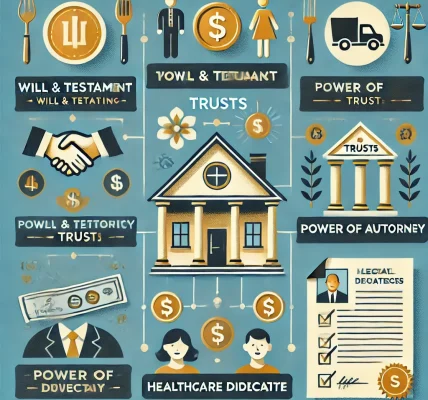Introduction
In an unpredictable world, having a solid financial safety net is essential. An emergency fund acts as a financial buffer, helping you cover unexpected expenses such as medical bills, job loss, car repairs, or urgent home maintenance. Without an emergency fund, you may have to rely on loans or credit cards, which can lead to debt and financial stress.
Building a bulletproof emergency fund in 2025 requires careful planning, discipline, and strategic decision-making. In this comprehensive guide, we will explore the best strategies to build and maintain an emergency fund that provides financial security and peace of mind.
Why an Emergency Fund is Essential
1. Protection Against Unforeseen Expenses
Life is full of surprises, and not all of them are pleasant. A sudden medical emergency, car breakdown, or home repair can disrupt your finances. An emergency fund helps you manage such unexpected costs without derailing your budget.
2. Job Security in an Uncertain Economy
With evolving job markets and economic fluctuations, employment stability is never guaranteed. Having a financial cushion ensures that you can cover your basic expenses while searching for a new job or adjusting to changes in income.
3. Avoiding Debt Traps
Without savings, people often resort to high-interest loans or credit cards to handle emergencies. This can lead to a cycle of debt, making financial recovery even more difficult. A strong emergency fund eliminates the need for borrowing in times of crisis.
4. Peace of Mind and Financial Independence
Knowing you have a safety net provides mental and emotional relief, allowing you to make better financial and life decisions without constant worry about unexpected expenses.
Step-by-Step Guide to Building an Emergency Fund
1. Determine Your Ideal Emergency Fund Size
The amount needed for an emergency fund varies depending on lifestyle, income, and financial responsibilities. A general rule of thumb is:
- Minimum: 3 months’ worth of essential expenses
- Ideal: 6 to 12 months’ worth of essential expenses
Calculate your monthly essentials, including rent/mortgage, utilities, groceries, transportation, and insurance. Multiply this amount by your desired number of months to determine your emergency savings goal.
2. Set Clear Savings Goals
Break your total savings target into manageable milestones. For example:
- Short-term goal: Save one month’s worth of expenses within 3 months
- Mid-term goal: Save 3 months’ worth of expenses within a year
- Long-term goal: Build up to 6–12 months of expenses over time
Having clear goals helps you stay motivated and track progress effectively.
3. Create a Realistic Budget
Budgeting is crucial to successfully growing your emergency fund. Follow these steps:
- Track your income and expenses
- Identify areas where you can cut costs (e.g., dining out, entertainment, subscriptions)
- Allocate a fixed percentage of your income toward emergency savings each month
Popular budgeting methods include:
- 50/30/20 Rule: Allocate 50% of income to needs, 30% to wants, and 20% to savings (including emergency fund contributions).
- Zero-Based Budgeting: Assign every dollar of income a specific purpose, ensuring savings are a priority.
4. Automate Your Savings
Setting up automatic transfers to a dedicated emergency savings account ensures consistency and prevents the temptation to spend the money elsewhere. Schedule these transfers to coincide with your paycheck deposit to make saving effortless.
5. Choose the Right Savings Account
Store your emergency fund in an account that is:
- Easily accessible: You should be able to withdraw funds quickly when needed.
- Separate from your regular checking account: This prevents accidental spending.
- High-yielding: Consider a high-yield savings account or money market account to earn interest while keeping your funds safe.
6. Reduce Unnecessary Expenses
Cutting back on non-essential spending can accelerate your savings. Consider:
- Cooking at home instead of eating out
- Canceling unused subscriptions and memberships
- Using public transportation or carpooling to save on fuel
- Shopping smart with discounts, coupons, and cashback programs
7. Increase Your Income
If saving from your current income seems difficult, explore ways to boost your earnings:
- Take on freelance work or a side hustle
- Sell unused items online
- Ask for a raise or look for higher-paying job opportunities
- Invest in skill development to increase earning potential
8. Use Windfalls Wisely
Any unexpected financial gain, such as tax refunds, bonuses, or monetary gifts, should be directed toward your emergency fund instead of being spent on non-essential purchases.
9. Avoid Using Your Emergency Fund for Non-Essential Expenses
Discipline is key to maintaining your emergency savings. Only use the funds for genuine emergencies, and replenish them as soon as possible after withdrawal.
10. Regularly Review and Adjust Your Emergency Fund
Your financial situation may change over time due to lifestyle adjustments, inflation, or new responsibilities. Periodically reassess your emergency fund to ensure it remains adequate for your needs.
Common Mistakes to Avoid
1. Not Starting Early Enough
Many people delay emergency fund savings until a financial crisis hits. The sooner you start, the better prepared you’ll be for unforeseen events.
2. Saving Too Little or Too Much
Saving too little can leave you vulnerable in a crisis, while saving excessively may prevent you from investing in higher-return financial opportunities. Find the right balance based on your needs.
3. Keeping the Money in a Low-Interest Account
Storing your emergency fund in a regular checking account means missing out on interest earnings. Opt for a high-yield savings account instead.
4. Dipping Into the Fund for Non-Essential Expenses
Using emergency savings for vacations, shopping, or non-essential upgrades defeats its purpose. Maintain strict discipline.
5. Not Replenishing the Fund After Use
Once you use your emergency fund, make it a priority to rebuild it as soon as possible to ensure continued financial security.
Conclusion
Building a bulletproof emergency fund in 2025 is an essential step toward financial independence and stress-free living. By setting clear goals, creating a realistic budget, cutting unnecessary expenses, automating savings, and choosing the right savings account, you can protect yourself from financial uncertainty. Stay disciplined, avoid common mistakes, and regularly review your savings strategy to maintain a strong financial safety net.
Start today, and secure your future with a well-planned emergency fund!




